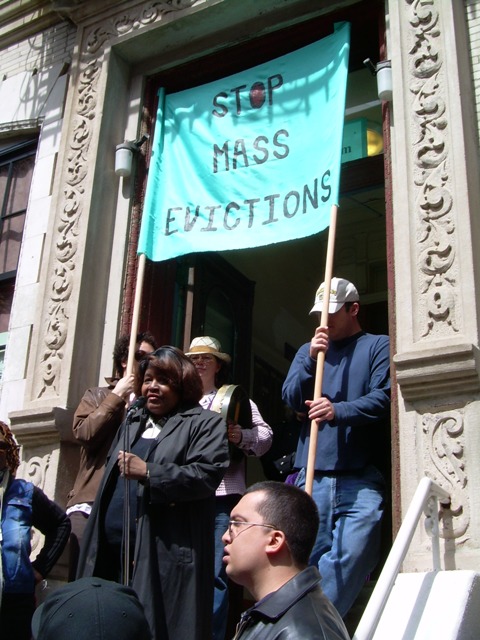Making Change: Activism Under Obama

Housing
Welcome to the first in a series of columns devoted to nonviolent activism under the new administration. The candidate who promised change is now in the White House, but as always, real change must come from us. Throughout Obama’s presidency, we will explore various key organizing issues and how things have changed … or stayed the same. Email win [at] warresisters.org with your ideas for future columns.
Protesting under President Obama will require a different style than was used under George W. Bush. One of the tenets of nonviolent protest is to appeal to your adversary’s better nature, but Bush showed no sign of having one. His values were so fundamentally based upon the divine right of imperial bullies—that the wealthy were ordained to rule the nation and the world, and everyone else was an undeserving loser or fiendish terrorist—that there was no hope of persuading him.
Barack Obama is conceivably persuadable, so he will require a less antagonistic style. He’s a former community organizer, so he presumably has some compassion and knows what people are up against. He campaigned on a message of change, hailing the heroism of the union movement of the 1930s and the civil rights movement of the 1960s, so protests could be focused on urging him to live up to the spirit of his campaign.
On the other hand, Obama is now the leader of a country whose political and economic power elites want to retain their privileges despite the economic disaster they have created. Judging by the number of Bill Clinton retreads in his administration and his timidity about confronting Wall Street, these are the people who have his ear.
If we want Obama’s ear, we’ll have to be loud. We’ll have to challenge the tyranny of corporate-imperial ideology disguised as infallible bipartisan wisdom. Do we want a president who will undo the damage done by 30 years of Reaganomics or one who will merely be a more competent CEO and warlord than the mad cowboys from Texas were?
The housing crisis offers much potential for nonviolent direct action. In the 1930s, neighborhoods organized to resist evictions. When someone was thrown out of his or her home, crowds of protesters would carry the person’s possessions back in. In January, Rep. Marcy Kaptur (D-Ohio) told foreclosed people to “stay in your homes” and not leave.
That kind of action has already happened in several cities. On February 19 in Baltimore, ACORN organizers broke into a foreclosed house and gave it back to the owner, replacing the padlock on the front door with a lock she had keys for. In Minneapolis, the Poor People’s Economic Rights Campaign broke into vacant houses and moved homeless families in.
In Boston, groups led by City Life/Vida Urbana have stalled evictions in the Roxbury and Dorchester neighborhoods by holding sit-ins at foreclosed houses on the day the residents were supposed to be thrown out.
“Each time, the lending institution has backed down and said they would negotiate,” City Life/Vida Urbana organizer Steve Meacham said last year. But financial institutions, he added, were reluctant to agree to any deal that would make them “admit the buildings have lost half their bubble value.”
The movement has won some victories. In December, mortgage companies Fannie Mae and Freddie Mac decided that they would not evict tenants from houses they foreclosed on.
Foreclosures, however, are a symptom of a much deeper crisis in housing affordability. Even before the bubble peaked, housing costs in many areas had risen tenfold since the 1970s. The centers of political power and media attention generally ignore renters’ issues. One-third of the households in the United States are renters, yet Obama scarcely mentioned them during the campaign. Nationally, about 40 percent of people who lose their homes through foreclosure are renters. Except in cities where rent controls protect them, those tenants have almost no rights to stay and can be evicted without any warning. In the last 15 years, rent controls have been eliminated in Massachusetts and gutted in New York and California.
RENT STRIKE
Perhaps the most effective way to lower rents would be the riskiest and hardest to organize: a mass rent strike. As nonviolent direct action, rent strikes and resisting evictions have the potential to be far more effective than conventional civil disobedience. If successful, they actually disrupt the machinery of greed and oppression, instead of just symbolically expressing opposition.
Resistance is not enough, however. Unless it is linked to a concrete political program, it is merely temporary venting. In housing, what we need most are strict rent controls, protection for people in foreclosed buildings, and massive construction of affordable housing. This would also create construction jobs and could be a vehicle for conversion to solar and wind energy.
The housing crisis is intimately connected to the financial crisis. President Obama might choose to take measures to help the millions of Americans stressed by job loss and inflated housing and health costs. He might also continue shoveling money to speculators who have spent 30 years preaching about the moral glories of the free market and are now whining for the government to buy up their glorified Ponzi-scheme investments.
What Obama decides will likely depend on our actions, whether we can create a movement strong enough to push him to do the right thing. If he doesn’t hear our voices, he’s going to do the wrong thing.
